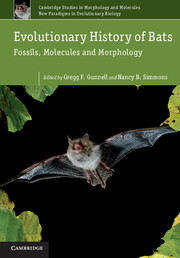Book contents
- Frontmatter
- Contents
- Contributors
- Preface
- 1 Phylogenies, fossils and functional genes: the evolution of echolocation in bats
- 2 Systematics and paleobiogeography of early bats
- 3 Shoulder joint and inner ear of Tachypteron franzeni, an emballonurid bat from the Middle Eocene of Messel
- 4 Evolutionary history of the Neotropical Chiroptera: the fossil record
- 5 New basal noctilionoid bats (Mammalia: Chiroptera) from the Oligocene of subtropical North America
- 6 Necromantis Weithofer, 1887, large carnivorous Middle and Late Eocene bats from the French Quercy Phosphorites: new data and unresolved relationships
- 7 African Vespertilionoidea (Chiroptera) and the antiquity of Myotinae
- 8 Evolutionary and ecological correlates of population genetic structure in bats
- 9 A bird? A plane? No, it's a bat: an introduction to the biomechanics of bat flight
- 10 Toward an integrative theory on the origin of bat flight
- 11 Molecular time scale of diversification of feeding strategy and morphology in New World Leaf-Nosed Bats (Phyllostomidae): a phylogenetic perspective
- 12 Why tribosphenic? On variation and constraint in developmental dynamics of chiropteran molars*
- 13 Necromantodonty, the primitive condition of lower molars among bats
- 14 Echolocation, evo-devo and the evolution of bat crania
- 15 Vertebral fusion in bats: phylogenetic patterns and functional relationships
- 16 Early evolution of body size in bats
- Index
- Plate section
- References
16 - Early evolution of body size in bats
Published online by Cambridge University Press: 05 June 2012
- Frontmatter
- Contents
- Contributors
- Preface
- 1 Phylogenies, fossils and functional genes: the evolution of echolocation in bats
- 2 Systematics and paleobiogeography of early bats
- 3 Shoulder joint and inner ear of Tachypteron franzeni, an emballonurid bat from the Middle Eocene of Messel
- 4 Evolutionary history of the Neotropical Chiroptera: the fossil record
- 5 New basal noctilionoid bats (Mammalia: Chiroptera) from the Oligocene of subtropical North America
- 6 Necromantis Weithofer, 1887, large carnivorous Middle and Late Eocene bats from the French Quercy Phosphorites: new data and unresolved relationships
- 7 African Vespertilionoidea (Chiroptera) and the antiquity of Myotinae
- 8 Evolutionary and ecological correlates of population genetic structure in bats
- 9 A bird? A plane? No, it's a bat: an introduction to the biomechanics of bat flight
- 10 Toward an integrative theory on the origin of bat flight
- 11 Molecular time scale of diversification of feeding strategy and morphology in New World Leaf-Nosed Bats (Phyllostomidae): a phylogenetic perspective
- 12 Why tribosphenic? On variation and constraint in developmental dynamics of chiropteran molars*
- 13 Necromantodonty, the primitive condition of lower molars among bats
- 14 Echolocation, evo-devo and the evolution of bat crania
- 15 Vertebral fusion in bats: phylogenetic patterns and functional relationships
- 16 Early evolution of body size in bats
- Index
- Plate section
- References
Summary
Introduction
Size is the single most important factor affecting physiology, locomotion, ecology and behavior of mammals (MacNab, 2007 and citations therein). Understanding evolution of size is important in all organisms, but especially so in cases like bats which exhibit many energetically expensive behaviors (e.g., powered flight, echolocation, long-distance migration), as well as characteristics that represent extreme energy-saving mechanisms (e.g., torpor and hibernation). Most bat species are small: from data in Smith et al. (2004), the central tendency in size in extant bats, as estimated by the median value, is around 14 g (Figure 16.1). However, size in bats as a group spans three orders of magnitude, ranging from 2–3 g (e.g., Craseonycteris, Thyroptera, Furipterus, some vespertilionids; Smith et al., 2004) to a few species exceeding 1 kg (e.g., Acerodon jubatus, Pteropus vampyrus; Kunz and Pierson, 1994). This variation in size scales a number of fundamental traits in bats, including physiological features (e.g., basal metabolic rate; McNab and Bonaccorso, 2001; MacNab, 2003, Speakman and Thomas, 2003); aerodynamic performance (Norberg, 1986, 1990; Rayner, 1986; Watts et al., 2001); dimensions of limb bones and their biomechanical properties (Swartz, 1997, 1998; Swartz and Middleton, 2008); behaviors (e.g., extreme dietary habits like carnivory; Norberg and Fenton, 1988); echolocation call parameters (Jones, 1999); and most life-history traits (e.g., litter mass; Hayssen and Kunz, 1996). These traits likely have an important phylogenetic component of variation, as has been shown, for instance, for the relationship of basal metabolic rate to body mass (Cruz-Neto et al., 2001; cf. MacNab, 2007). Besides the many dependent variables responding to body mass in various ways, size is a fundamental trait that should be understood by itself as an evolving character in bat lineages.
- Type
- Chapter
- Information
- Evolutionary History of BatsFossils, Molecules and Morphology, pp. 530 - 555Publisher: Cambridge University PressPrint publication year: 2012
References
- 23
- Cited by



